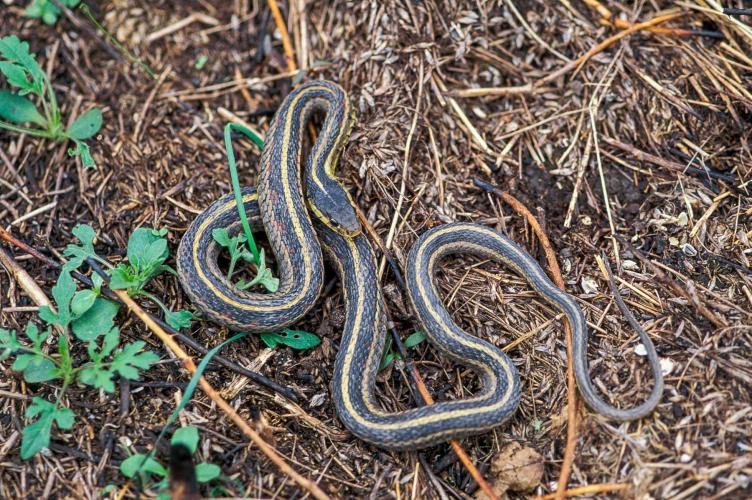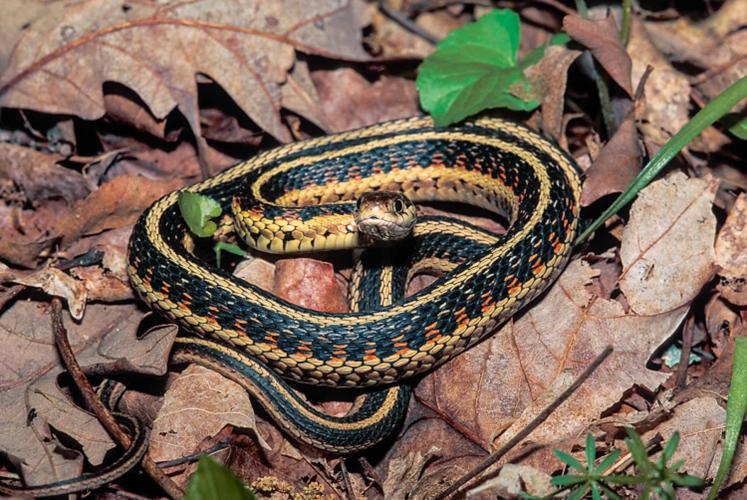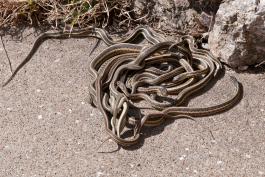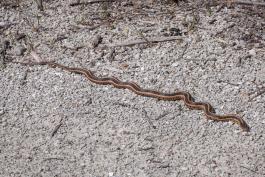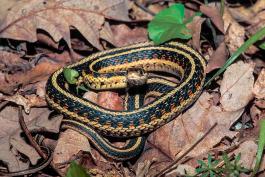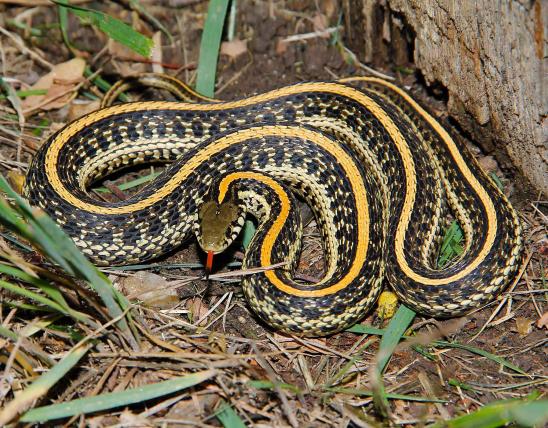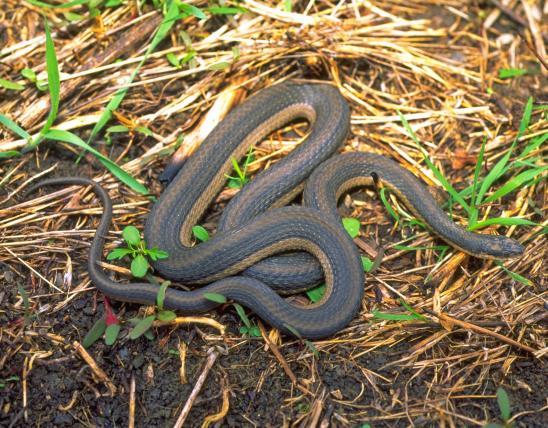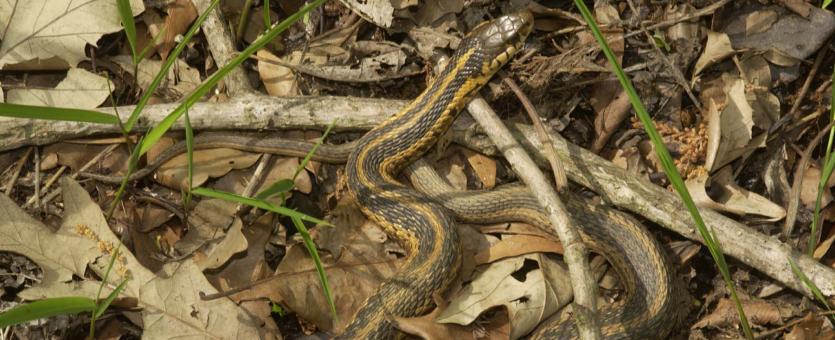
The eastern gartersnake and red-sided gartersnake are Missouri's most common gartersnakes. They are medium-sized, harmless snakes that are familiar to many. They are Missouri's two subspecies of the common gartersnake (Thamnophis sirtalis):
- The eastern gartersnake (Thamnophis sirtalis sirtalis) is widespread in the eastern half of the United States and is present in the southeastern two-thirds of Missouri.
- The red-sided gartersnake (Thamnophis sirtalis parietalis) is a Great Plains subspecies and is present in the northwestern two-thirds of Missouri.
There is a broad zone of overlap of the two subspecies in a southwest-to-northeast band covering about the middle third of the state. In this zone, the two subspecies interbreed and may show variable amounts of red on the sides.
In both the eastern and red-sided subspecies, there are narrow black bars (not boldly marked black bars) between the scales along the upper jaw.
- The general color of the eastern gartersnake (T. s. sirtalis) is variable; it may be black, brown, or olive. There are usually three distinct light stripes that are yellow, brown, green, or blue. One light stripe runs along the back, and one along each side. The area between the stripes on each side usually has a double row of alternating dark spots. The belly is green with two rows of faint black spots that are somewhat hidden by the overlapping scales.
- The red-sided gartersnake (T. s. parietalis) is similar to the eastern gartersnake. The major difference between it and the eastern subspecies is that the red-sided gartersnake has red or orangish-red skin visible between the scales along the sides.
Gartersnakes are harmless, but they may bite to defend themselves and typically expel a foul-smelling musk on attackers.
Similar species: Missouri has two other gartersnake species: the plains gartersnake (Thamnophis radix) and the orange-striped ribbonsnake (Thamnophis proximus proximus). The markings (or lack of markings) on the upper jaw scales (supralabial scales) are key characters:
- The plains gartersnake has boldly marked (not narrow) black bars between the scales along the upper jaw.
- The orange-striped ribbonsnake has unmarked scales along the upper jaw: they are plain white or pale green, lacking black bars, and the light coloration of this "upper lip" contrasts against the ribbonsnake's dark head.
Adult length: to 18–26 inches; occasionally to 54 inches.
The common gartersnake species occurs statewide in Missouri. The eastern gartersnake subspecies lives in the southeastern two-thirds of the state, and the red-sided gartersnake subspecies is in the northwestern two-thirds. The two subspecies overlap and intergrade in a southwest-to-northeast band covering about the middle third of the state.
Habitat and Conservation
Eastern gartersnakes are normally active in March–early November, but they may be seen aboveground during mild winters. They are mainly active during the day.
They live in a variety of habitats but favor areas near water, such as ponds, marshes, swamps, or damp, wooded areas along creeks and rivers. They also live in empty lots, brushy fencerows, roadside ditches, and old abandoned farms. They are often found under boards, rocks, or other objects in city lots and near farm buildings.
In winter, they take shelter in animal burrows or rotting stumps, or congregate in deep cracks in south-facing limestone bluffs or rocky hillsides. In the prairie regions of western and northern Missouri, gartersnakes overwinter in crayfish burrows and ant mounds.
These gartersnakes are often found near people. They will overwinter in holes in fields, pastures, lawns, old rock-lined wells, cisterns, and foundations of abandoned homes. In lawns, eastern mole tunnels are another place where gartersnakes will spend winter.
The habitats of red-sided gartersnakes are similar to those of the eastern gartersnake.
Food
These gartersnakes eat earthworms, frogs, tadpoles, toads, and salamanders. They occasionally eat snails, slugs, insects, minnows, small mice, and small snakes of other species. Amphibians usually make up most of the diet.
Status
Harmless, nonvenomous, common, sometimes abundant Missouri snakes.
Because they often live in yards and gardens near people's homes, they are some of the most frequently encountered snakes in Missouri.
Because of its ability to live in a wide variety of habitats and annual production of large litter sizes, this species is considered abundant and secure in Missouri. Protection and restoration of the species' preferred bottomland prairie habitat, however, will ensure it remains abundant on the Missouri landscape.
Taxonomy: Missouri has these two subspecies of common gartersnake, but there are about 10 more subspecies that occur in North America.
Life Cycle
Courtship and mating is usually in spring, soon after the snakes emerge from overwintering. Sometimes mating may occur in the fall. A number of males may try to court and mate with a single female, with much writhing as the males try to rub against the female. Females give birth to live young in the middle of summer and early fall; a litter may contain 4–85 young but usually about 24. Males become sexually mature after one or two years of life, females after two or three. Lifespan can exceed 14 years.
Human Connections
When cornered, this snake often flattens its head and body and tries to strike. Like many kinds of harmless snakes, gartersnakes will bite to defend themselves. These and other gartersnakes will secrete a foul-smelling musk from glands at the base of the tail when first captured.
Fear and myth still surround snakes, due largely to a lack of knowledge about them. Fortunately, the biology and natural history of Missouri snakes are both interesting and enjoyable to learn. People who understand snakes tolerate and appreciate them as a natural part of outdoor Missouri.
Gartersnakes have lengthwise stripes that are reminiscent of old-fashioned men's sock garters, which were frequently striped, hence the common name.
Ecosystem Connections
As predators, gartersnakes help keep populations of other animals in check. Although they can defend themselves by trying to bite and by smearing foul-smelling musk on attackers, they and their young provide food for many predators.
The common gartersnake, as a species, is more tolerant of cold temperatures than most other snake species, so it is one of the first to emerge from winter dormancy and one of the last to enter. Also, it helps explain this species' northern range, which extends well into Canada's provinces, southeastern Alaska, and even southern parts of the Northwest Territories.
A third subspecies of common gartersnake may also be present in our state: in southwestern Missouri, some representatives of this species have a broad orange stripe along their backs that is characteristic of Texas gartersnakes (Thamnophis sirtalis annectens), a subspecies found in Texas and western Oklahoma. Future genetic studies should help determine these snakes' identity.



